
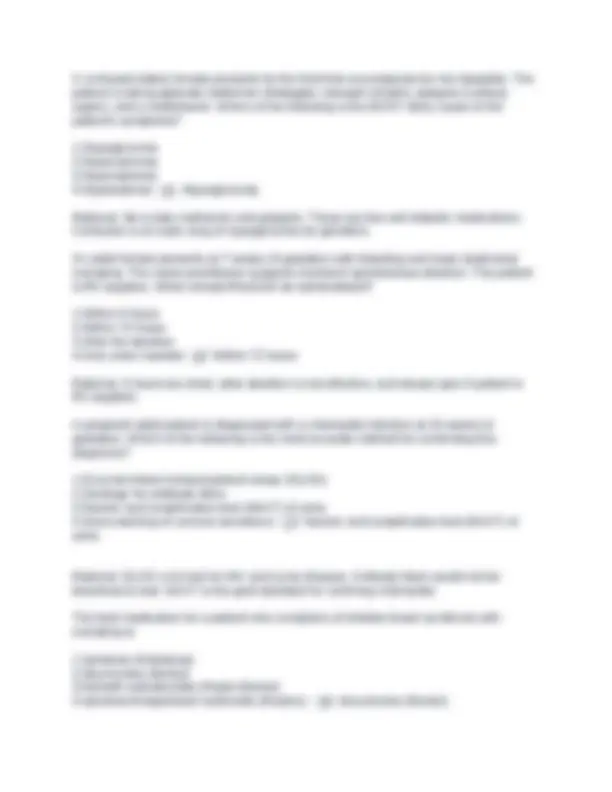
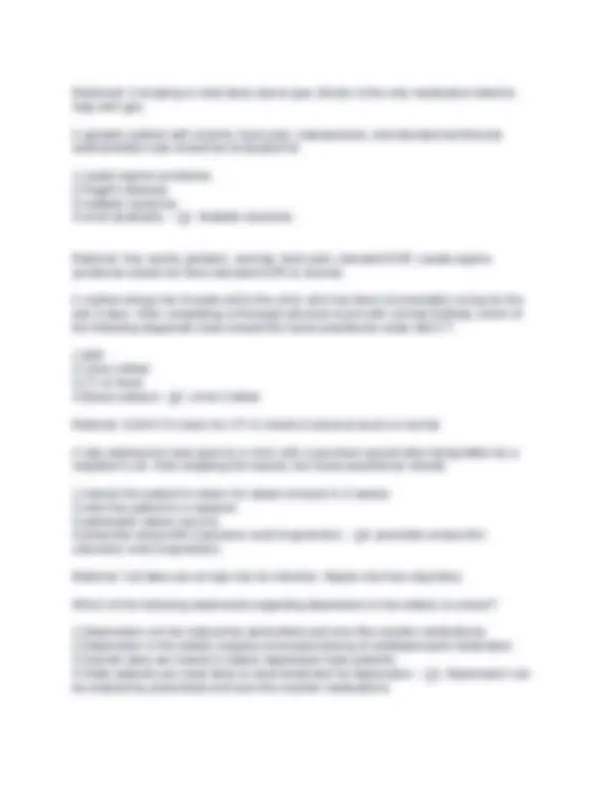
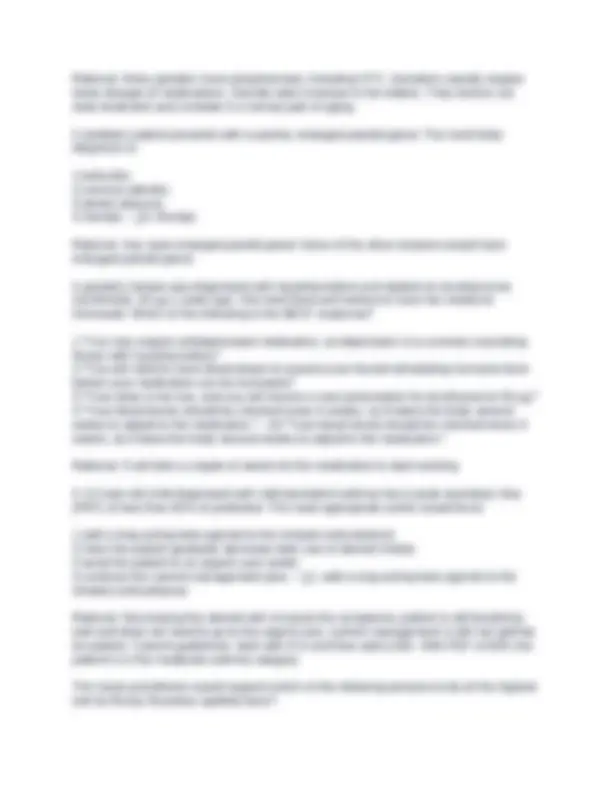
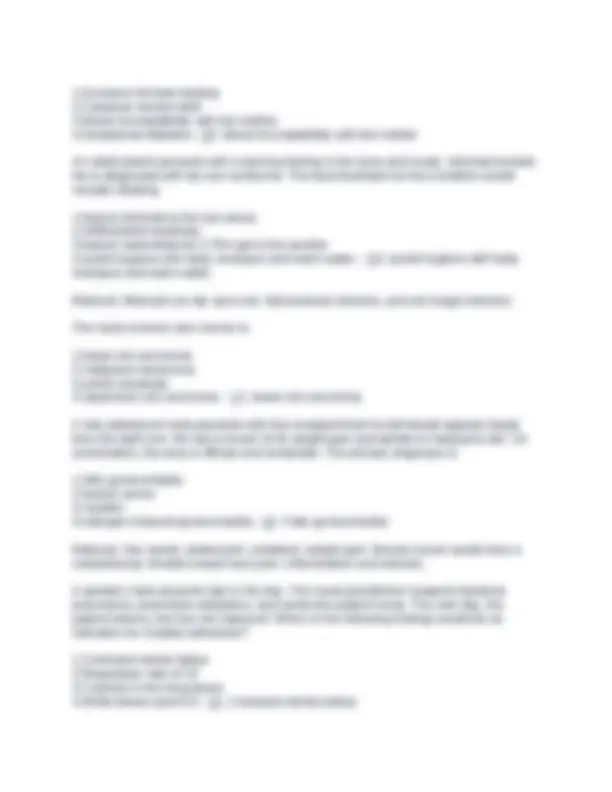
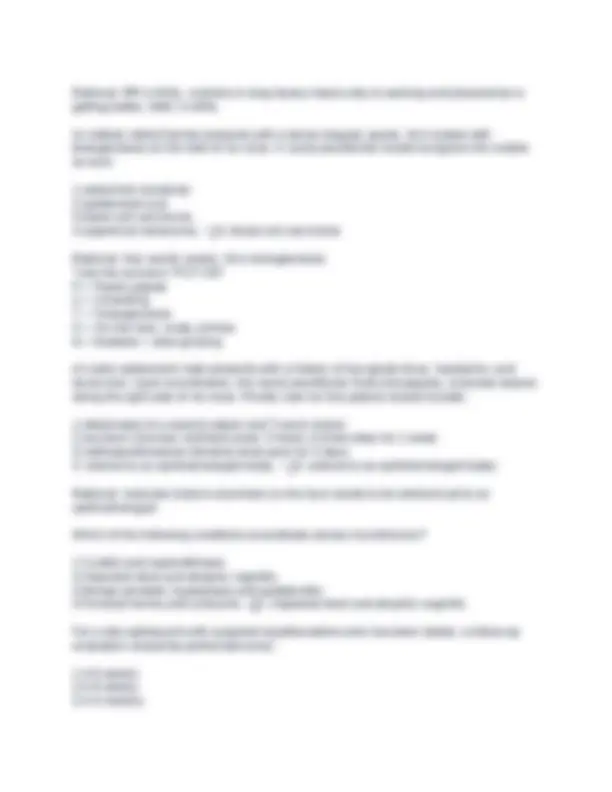
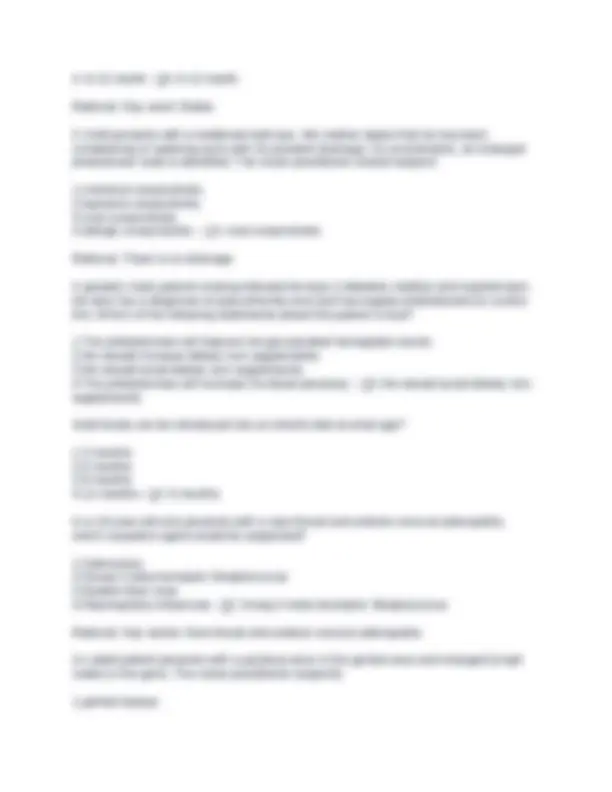
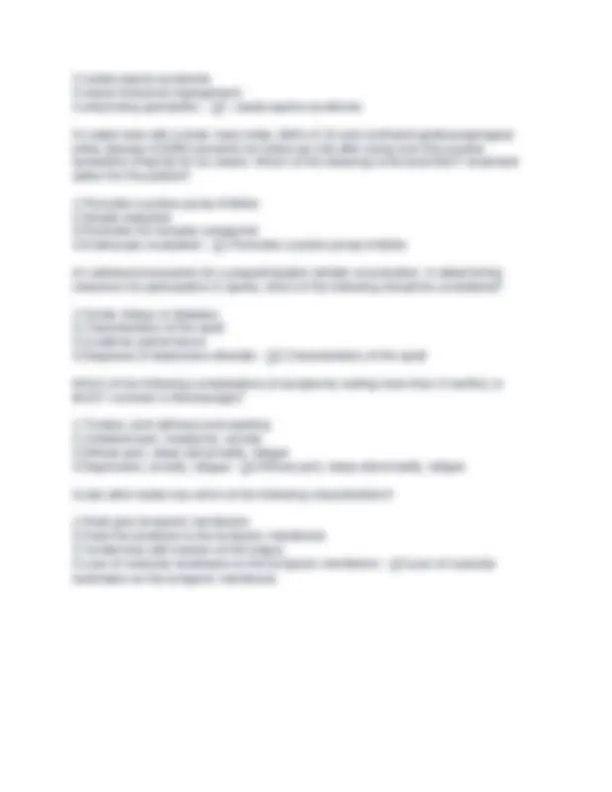


Study with the several resources on Docsity

Earn points by helping other students or get them with a premium plan


Prepare for your exams
Study with the several resources on Docsity

Earn points to download
Earn points by helping other students or get them with a premium plan
Community
Ask the community for help and clear up your study doubts
Discover the best universities in your country according to Docsity users
Free resources
Download our free guides on studying techniques, anxiety management strategies, and thesis advice from Docsity tutors
PSai- FNP 2020 Questions& Answers.
Typology: Exams
1 / 13

This page cannot be seen from the preview
Don't miss anything!








Which of the following is a common cause of acne? 1.Use of oral contraceptives 2.Ingestion of soda and chocolate 3.Increase in androgens 4.Low-glycemic diet - ✅3. Increase in androgens Rational: Oral contraceptives help control acne and decrease androgens. Soda and chocolate have not been proven to have a significant impact on acne. Which trimester of pregnancy is a woman with a fundal height measurement at the umbilicus? 1.First 2.Second 3.Third 4.Fourth - ✅2. Second Rational: The level of the umbilicus is 20 weeks. There are 3 trimesters divided into, 1st (0-13 weeks), 2nd (14-26 weeks), 3rd (27-40 weeks). Which of the following conditions is a risk factor for development of deep vein thromboembolism and pulmonary embolism? 1.Visceral malignancy 2.Sudden weight gain 3.Copper IUD insertion 4.Aerobic exercise - ✅1. Visceral malignancy Rational: Cancers of the brain, ovary, pancreas, colon, stomach, lung and kidney have the highest risk of DVT/PE. An adult male presents with intermittent retrosternal burning. He has gained 30 lb in the past year. Physical examination results are unremarkable and the EKG is normal. The most likely diagnosis is: 1.pericarditis. 2.gastroesophageal reflux. 3.cholecystitis. 4.costochondritis. - ✅2. .gastroesophageal reflux (GERD)
Rational: Look at the key words: retrosternal burning, weight gain, unremarkable physical exam. Pericarditis would most likely have other symptoms persistent fatigue and shortness of breath, swelling of the feet, legs and abdomen often with weight gain (heart failure type symptoms). cholecystitis would have an abnormal physical exam and not retrosternal burning. costochondritis might mimic that of a heart attack or other heart conditions. Pain with breathing. A geriatric patient presents with a bump on the vulva, associated with pruritis and malodorous drainage. Examination reveals a raised, ulcerated lesion. The most likely diagnosis is: 1.vulvar cancer. 2.lymphogranuloma inguinale. 3.vulvar atrophy. 4.Paget's disease. - ✅1. Vulvar Cancer Rational: Key words, geriatric, bump, pruritus. lymphogranuloma inguinale and vulvar atrophy there is no bump. Paget's disease is a bone disease. A geriatric female complains of problems with urination. She reports that whenever she feels the need to urinate, she is unable to "make it to the bathroom in time," and wets herself. Which type of incontinence is most likely? 1.Urge 2.Overflow 3.Transient 4.Stress - ✅1. Urge Rational: Key words, geriatric, feels the need. Transient is due to an underline medical problem. Stress is due to increase pressure/stress An adult patient presents with complaints of nausea, fatigue, and myalgia. The patient reports a history of untreated hepatitis B 30 years ago. Which hepatitis B serology testing results would indicate that the patient has chronic hepatitis? 1.HBsAg = negative, anti-HBc = positive 2.HBsAg = positive, IgM anti-HBc = negative 3.HBsAg = positive, IgM anti-HBc = positive 4.HBsAg = negative, anti-HBs = positive - ✅2. HBsAg = positive, IgM anti-HBc = negative Rational: HBsAg means infected IgM anti-HBc means immune
Rantional: Cramping is most likely due to gas. Bentyl is the only medication listed to help with gas. A geriatric patient with anemia, back pain, osteoporosis, and elevated erythrocyte sedimentation rate should be evaluated for: 1.cauda equina syndrome. 2.Paget's disease. 3.multiple myeloma. 4.renal dystrophy. - ✅1. Multiple myeloma Rational: Key words, geriatric, anemia, back pain, elevated ESR. cauda equina syndrome would not have elevated ESR or anemia. A mother brings her 8-week-old to the clinic who has been inconsolably crying for the last 3 days. After completing a thorough physical exam with normal findings, which of the following diagnostic tests should the nurse practitioner order NEXT? 1.MRI 2.Urine culture 3.CT of head 4.Blood cultures - ✅2. Urine Culture Rational: ALWAYS check for UTI in infants if physical exam is normal A late adolescent male goes to a clinic with a puncture wound after being bitten by a neighbor's cat. After irrigating the wound, the nurse practitioner should: 1.instruct the patient to return for suture removal in 2 weeks. 2.refer the patient to a surgeon. 3.administer rabies vaccine. 4.prescribe amoxicillin-clavulanic acid (Augmentin). - ✅4. prescribe amoxicillin- clavulanic acid (Augmentin). Rational: Cat bites are at high risk for infection. Higher risk than dog bites. Which of the following statements regarding depression in the elderly is correct? 1.Depression can be induced by prescribed and over-the-counter medications. 2.Depression in the elderly requires increased dosing of antidepressant medication. 3.Suicide rates are lowest in elderly depressed male patients. 4.Older patients are most likely to seek treatment for depression. - ✅1. Depression can be induced by prescribed and over-the-counter medications.
Rational: Many geriatric have polypharmacy including OTC. Geriatrics usually require lower dosage of medications. Suicide rates increase in the elderly. They tend to not seek treatment and consider it a normal part of aging. A pediatric patient presents with a painful, enlarged parotid gland. The most likely diagnosis is: 1.torticollis. 2.cervical adenitis. 3.dental abscess. 4.mumps. - ✅4. Mumps Rational: Key work enlarged parotid gland. None of the other answers would have enlarged parotid gland. A geriatric female was diagnosed with hypothyroidism and started on levothyroxine (Synthroid), 25 μg 1 week ago. She feels tired and wishes to have her medicine increased. Which of the following is the BEST response? 1."You may require antidepressant medication, as depression is a common coexisting illness with hypothyroidism." 2."You will need to have blood drawn to assess your thyroid-stimulating hormone level before your medication can be increased." 3."Your dose is too low, and you will receive a new prescription for levothyroxine 50 μg." 4."Your blood levels should be checked every 6 weeks, as it takes the body several weeks to adjust to the medication." - ✅4."Your blood levels should be checked every 6 weeks, as it takes the body several weeks to adjust to the medication." Rational: It will take a couple of weeks for the medication to start working A 12-year-old child diagnosed with mild persistent asthma has a peak expiratory flow (PEF) of less than 80% of predicted. The most appropriate action would be to: 1.add a long-acting beta agonist to the inhaled corticosteroid. 2.have the patient gradually decrease daily use of steroid inhaler. 3.send the patient to an urgent care center. 4.continue the current management plan. - ✅1 .add a long-acting beta agonist to the inhaled corticosteroid. Rational: Decreasing the steroid with increase the symptoms, patient is still breathing well and does not need to go to the urgent care, current management is still not optimal for patient. Current guidelines: start with ICS and then add LABA. With PEF of 80% the patient is in the moderate asthma category The nurse practitioner would suspect which of the following persons to be at the highest risk for Rocky Mountain spotted fever?
An adult female presents complaining of an increase in a malodorous vaginal discharge that worsens after intercourse. Examination and testing reveal a vaginal pH of 5.5, presence of clue cells on the wet mount, and a positive whiff test. The most appropriate diagnosis is: 1.trichomoniasis. 2.bacterial vaginosis. 3.vaginal candidiasis. 4.cervicitis. - ✅2. BV Rational: pH 5.5, clue cells, + whiff test. Those are all signs of BV The preferred treatment for early syphilis is: 1.benzathine penicillin G, 2.4 million units IM once. 2.aqueous penicillin G, 18-24 million units every 3-4 hours. 3.tetracycline, 500 mg q.i.d. for 14 days. 4.ceftriaxone, 2 g IM once. - ✅1. benzathine penicillin G, 2.4 million units IM once. An early adolescent patient who plays football presents to clinic after a football practice complaining of limping due to anterior left knee pain. The pain has gradually increased over the past 2 weeks but is relieved with rest. The patient denies any trauma, prior surgeries, or medical history. Physical examination reveals tenderness and swelling of the tibial tubercle and reproduction of pain with resisted knee extension. The history and physical examination findings are most consistent with a diagnosis of: 1.Legg-Calvé-Perthes disease. 2.osteochondritis dissecans. 3.patellofemoral dysfunction. 4.Osgood-Schlatter disease. - ✅4. Osgood-Schlatter disease. Rational: Key words: adolescent, relieved with rest, tenderness and swelling of the tibial tubercle. Smoking marijuana leads to which of the following? 1.Increased heart rate 2.Improved pulmonary function 3.Decreased blood pressure 4.Increased testosterone levels - ✅1. Increased Heart Rate Rational: Does not improve PF but can lead to COPD. Would cause hypertension. Which of the following is the MOST common risk factor for developing severe hyperbilirubinemia in the newborn?
1.Exclusive formula feeding 2.Cesarean section birth 3.Blood incompatibility with the mother 4.Gestational diabetes - ✅3. Blood incompatibility with the mother An adult patient presents with a burning feeling in the eyes and crusty, inflamed eyelids. He is diagnosed with dry eye syndrome. The best treatment for this condition would include initiating: 1.topical retinoids to the eye areas. 2.antibacterial eyedrops. 3.topical metronidazole 0.75% gel to the eyelids. 4.eyelid hygiene with baby shampoo and warm water. - ✅4. eyelid hygiene with baby shampoo and warm water. Rational: Retinoid can dry eyes out. Not bacterial infection, and not fungal infection. The most common skin cancer is: 1.basal cell carcinoma. 2.malignant melanoma. 3.actinic keratosis. 4.squamous cell carcinoma. - ✅1. basal cell carcinoma. A late adolescent male presents with the complaint that his left breast appears larger than the right one. He had a recent 10-lb weight gain and admits to marijuana use. On examination, the area is diffuse and nontender. The primary diagnosis is: 1.fatty gynecomastia. 2.breast cancer. 3.mastitis. 4.estrogen-induced gynecomastia - ✅1. Fatty gynecomastia Rational: Key words: adolescent, unilateral, weight gain. Breast cancer would have a nodule/bump. Mastitis would have pain, inflammation and redness. A geriatric male presents late in the day. The nurse practitioner suspects bacterial pneumonia, prescribes antibiotics, and sends the patient home. The next day, the patient returns, but has not improved. Which of the following findings would be an indication for hospital admission? 1.Confused mental status 2.Respiratory rate of 24 3.Crackles in the lung bases 4.White blood count 9.5 - ✅1. Confused mental status
2.syphilis. 3.gonorrhea. 4.genital warts. - ✅2. syphilis. Rational: Key word: Painless ulcer and enlarged lymph node in groin. This would be stage 1 Which of the following diagnoses in a late adolescent male necessitates an immediate referral for evaluation by a specialist? 1.Urethritis 2.Epididymitis 3.Testicular torsion 4.Inguinal hernia - ✅3. Testicular Torsion An adult female patient presents to the emergency department for a sudden onset of severe lower abdominal pain. She describes the pain as stabbing. She denies nausea, vomiting, fever, or chills. The pain does not radiate. To confirm the diagnosis of an ectopic pregnancy, the nurse practitioner should order which imaging study? 1.Ultrasound 2.Abdominal CT with contrast 3.KUB 4.Abdominal CT without contrast - ✅1. Ultrasound Long-term management of a patient with stable COPD includes: 1.annual influenza vaccination. 2.oral corticosteroids. 3.continuous positive airway pressure. 4.regular mucolytic therapy. - ✅1. Influenza vaccination Major causes of chronic kidney disease include: 1.arthritis and long-term use of acetaminophen. 2.Frequent cystitis and cephalosporin use. 3.hypertension and chronic obstructive pulmonary disease. 4.amyloidosis and systemic lupus erythematosus. - ✅4. amyloidosis and systemic lupus erythematosus. Which of the following is associated with decreased risk of breast cancer? 1.Early menarche 2.Positive family history 3.Breast feeding 4.Late menopause - ✅3. Breast feeding
2.cauda equina syndrome. 3.neural foraminal impingement. 4.ankylosing spondylitis. - ✅2. cauda equina syndrome. An adult male with a body mass index (BMI) of 19 and continued gastroesophageal reflux disease (GERD) presents for follow-up visit after using over-the-counter famotidine (Pepcid) for six weeks. Which of the following is the best NEXT treatment option for this patient? 1.Prescribe a proton pump inhibitor 2.Weight reduction 3.Prescribe H2 receptor antagonist 4.Endoscopic evaluation - ✅1.Prescribe a proton pump inhibitor An adolescent presents for a preparticipation athletic examination. In determining clearance for participation in sports, which of the following should be considered? 1.Family history of diabetes 2.Characteristics of the sport 3.Academic performance 4.Diagnosis of depressive disorder - ✅2.Characteristics of the sport Which of the following constellations of symptoms, lasting more than 3 months, is MOST common in fibromyalgia? 1.Tinnitus, joint stiffness and swelling 2.Unilateral pain, headache, anxiety 3.Diffuse pain, sleep abnormality, fatigue 4.Depression, anxiety, fatigue - ✅3.Diffuse pain, sleep abnormality, fatigue Acute otitis media has which of the following characteristics? 1.Pearl grey tympanic membrane 2.Fluid line posterior to the tympanic membrane 3.Tenderness with traction of the tragus 4.Loss of ossicular landmarks on the tympanic membrane - ✅4.Loss of ossicular landmarks on the tympanic membrane